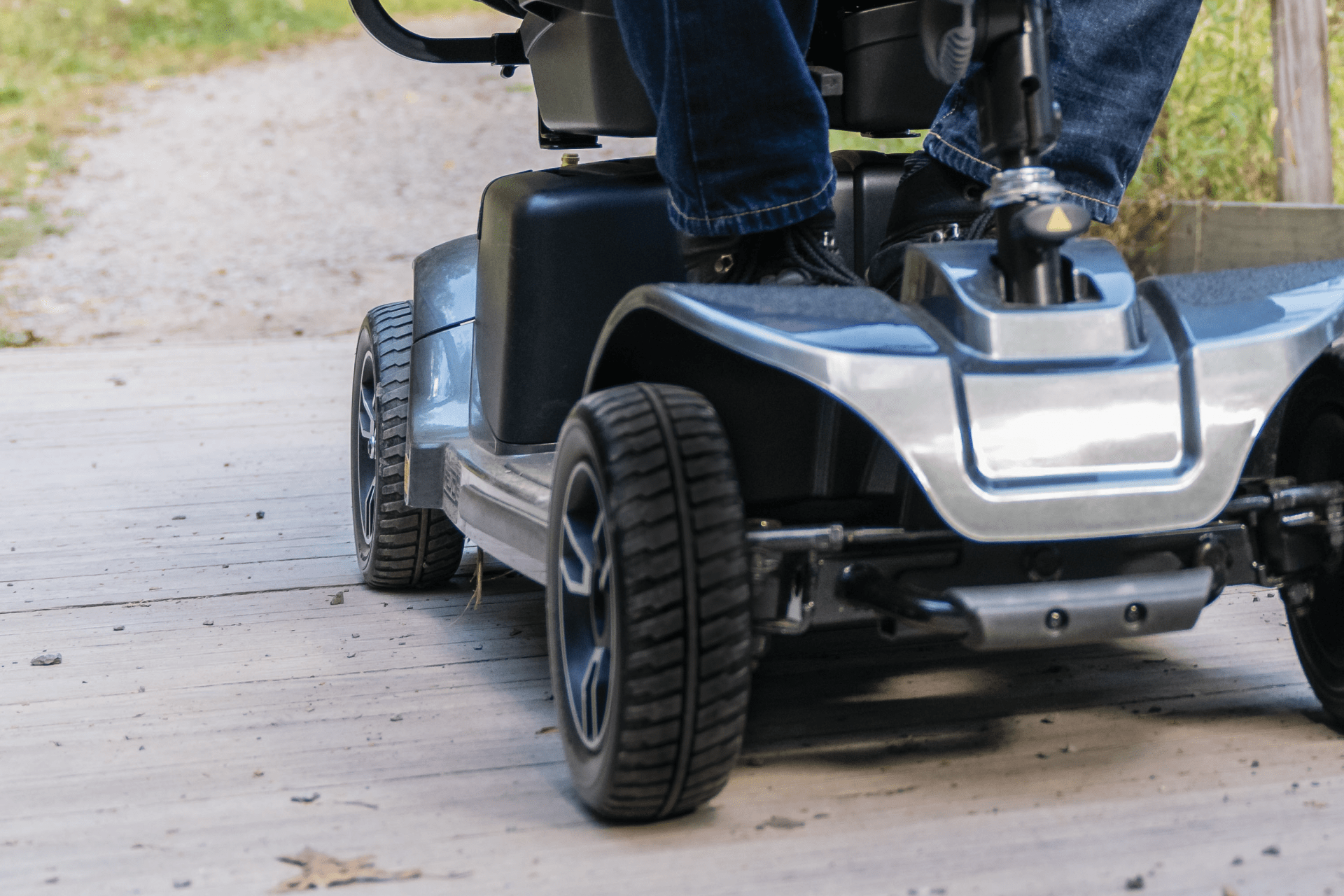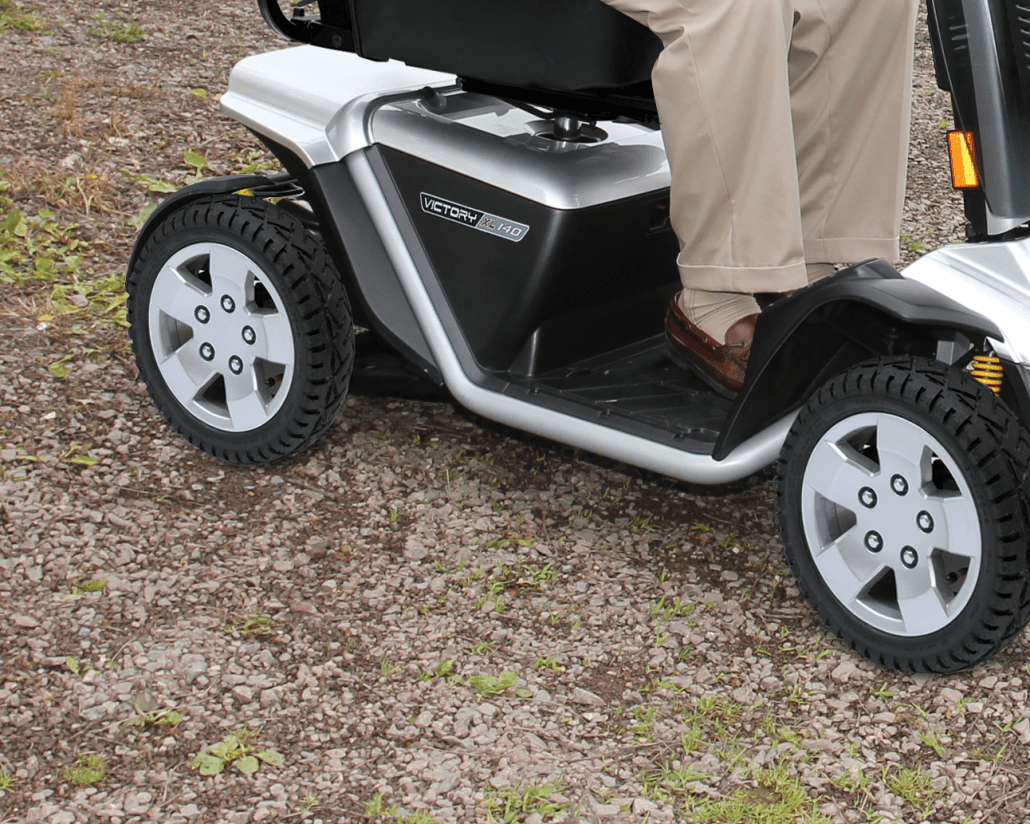Why do mobility devices have different kinds of tyres?
Pneumatic tyres vs. Flat-free tyres
Looking at a lineup of Pride Mobility devices, the different sizes, shapes, and tyre configurations are sure to stand out. Closer inspection reveals that some tyres are filled with air while others are solid. Some are filled with foam and others are perforated.
First, we’ll describe the two styles of tyres. Then, we’ll explain why different models require different tires and setups.

Pneumatic tyres vs. Flat-free tyres
Looking at a lineup of Pride Mobility devices, the different sizes, shapes and tire configurations are sure to stand out. Closer inspection reveals that some tyres are filled with air while others are solid. Some are filled with foam and others are perforated.
First, we’ll describe the two styles of tyres. Then, we’ll explain why different models require different tires and setups.
Pneumatic
Regular pneumatic tyres are rubber tyres filled with air. Pneumatic tyres provide better traction and a smoother ride than flat-free tyres. Pneumatic tyres are comparatively more efficient — allowing the vehicle to maximise speed and mileage. They also slip less and stop faster. Because they are filled with air, these tyres require more maintenance than a flat-free tyre. Users have to monitor air pressure and, yes, sometimes tend to flats.
Within this category, tyres can have a tube-like a bicycle tyre or be tubeless like a car tyre. When a tyre with a tube is punctured, the tube can typically be replaced and the rubber tyre reused. However, a punctured tubeless pneumatic tyre may need to be replaced.

Flat-free
Flat-free tyres are airless. They can be solid or filled with material like polyurethane or foam. The majority of Prime Mobility devices use flat-free tyres. As the name suggests, these tyres won’t go flat. There is no tyre gauge or air compressor needed. The lack of maintenance makes solid tires the best choice for daily-use wheelchairs or scooters. While flat-free tyres have less cushioning than air-filled tyres, the design of our devices often make up for that with sturdy suspension or additional wheels.
Within this category, tyres can have a tube-like a bicycle tyre or be tubeless like a car tyre. When a tyre with a tube is punctured, the tube can typically be replaced and the rubber tyre reused. However, a punctured tubeless pneumatic tyre may need to be replaced.
Mobility devices and their tyres
Now that we’ve got the tyre basics, let’s take a closer look at the scooters and power chairs in our fleet. Devices designed to travel on unsteady surfaces and long distances have pneumatic tyres. Flat-free tyres are ideal for riders who desire less maintenance.
Pneumatic tyres
The Pride Mobility scooters that come standard with pneumatic tyres are made for adventure.
The non-medical Ranger is our most rugged scooter. It has a 159 kg weight capacity and 7.7 peak horsepower twin motors. This heavy-duty ride sits tall on 14.5″ tubeless pneumatic tires. Confidently take on uneven terrain and be rewarded with great traction and a smooth ride.
Flat-free tyres
Our flat-free tyres are non-marking, which makes them ideal for travel from the house to the store and back again. These devices have a range of tyre configurations and sizes.
The Zero Turn 10 scooter gets you where you want to be. It has a max speed of 9.6 km/h and an ultra-tight turning radius of just 1092 mm. The superior maneuverability of the Zero Turn 10 comes from Pride’s patent-pending iTurn Technology. The individual rotating tires provide the best control available in the midsize mobility scooter class.
The 4-wheel model has 10.75″ solid rear tyres with 9″ solid front tyres. The Zero Turn 10 moves like a 3-wheel scooter with the stability of four wheels.
Another popular scooter model with flat-free tyres is the Victory 10 DX, available as a 4-wheel and 3-wheel model. The Victory has exclusive, low-profile tyres. These solid, non-scuff wheels are 3″ by 10″.
When it comes to Jazzy power wheelchairs, the tire sizes are even more varied. This is because wheelchairs often use casters — small mounted wheels that swivel in all directions — to maximize maneuverability.
The Jazzy Air 2 Victory 10 DX features an elevating seat that can position the rider at eye-level with others. The captain’s chair sits on a 641 mm by 843 mm base and travels on six solid wheels. The 10″ drive wheels are positioned toward the front of the base. The Jazzy Air 2 also has 6″ casters on the front and back.
The i-Go+ is the ultimate travel chair, weighing around 27.2 kg and folding down to a manageable 787 mm by 597 mm by 406 mm package. The travel-friendly Passport uses a lighter version of the flat-free tyre. The 11.25″ perforated drive wheels are lighter than solid tyres, but don’t require the maintenance of pneumatics. They offer more cushioning because of the air pockets. In front of the Jazzy Passport’s drive wheels are 8″ caster wheels.



